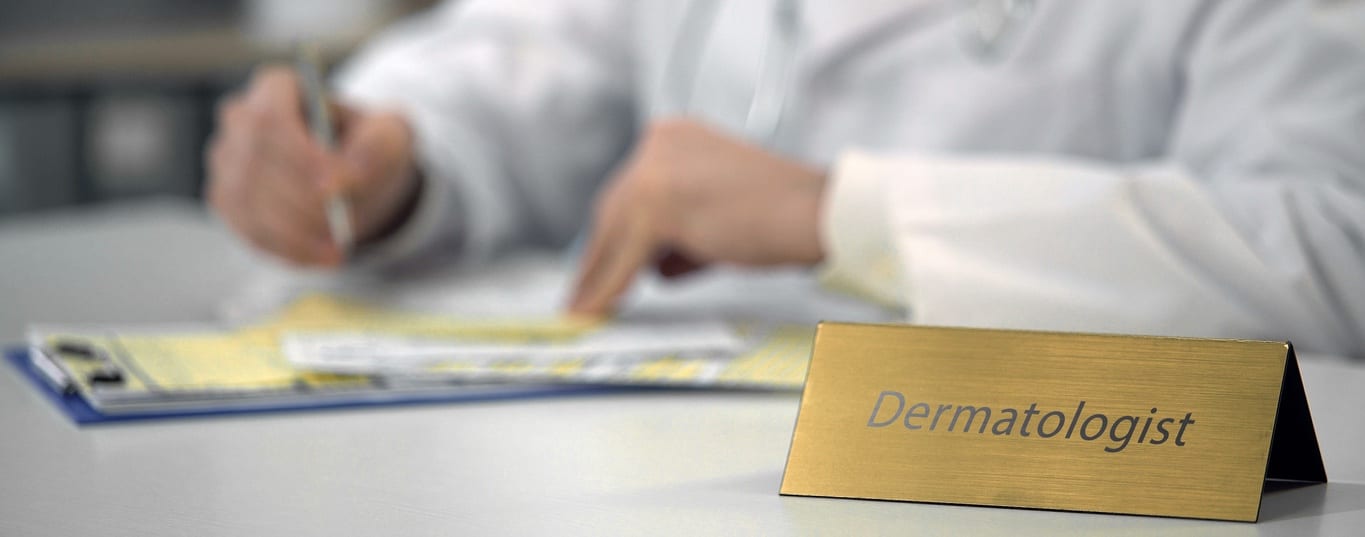Dermatofibrosarcoma Protuberans FAQs
What is dermatofibrosarcoma protuberans? »
 Dermatofibrosarcoma protuberans is a rare type of skin cancer that develops in the middle layer of the skin, the dermis. It grows slowly and seldom spreads. Treating it is important, however, as dermatofibrosarcoma protuberans can grow into surrounding fat, muscle, even bone. If that happens, it can be difficult to treat.
Dermatofibrosarcoma protuberans is a rare type of skin cancer that develops in the middle layer of the skin, the dermis. It grows slowly and seldom spreads. Treating it is important, however, as dermatofibrosarcoma protuberans can grow into surrounding fat, muscle, even bone. If that happens, it can be difficult to treat.
What are the symptoms of dermatofibrosarcoma protuberans? »
The first sign of dermatofibrosarcoma protuberans is usually a small bump on the skin. The area of skin will feel rubbery or hard to the touch. This will be red and may resemble a deep-seated pimple. As it grows, it will turn into a reddish-brown and slightly raised patch of skin. By the time the red bump becomes the brown patch, the cancer is growing more rapidly and may cause pain or bleed. This only occurs in roughly 15 percent of people with dermatofibrosarcoma protuberans.
Is dermatofibrosarcoma protuberans hereditary? »
Dermatofibrosarcoma protuberans does involve a mutation of the genetic material between chromosomes 17 and 22, but it is not a hereditary condition.
How rare are dermatofibrosarcoma protuberans? »
There are only about 1,000 cases of dermatofibrosarcoma protuberans in the United States every year. That equates to an incidence of between 0.8 and 5 per million people. It is twice as prevalent in African Americans, with an incidence of 6.5 per million people versus 3.9 per million in whites.
Dermatofibrosarcoma protuberans is rare skin cancer.
 What causes dermatofibrosarcoma protuberans? »
What causes dermatofibrosarcoma protuberans? »
The causes of this rare form of skin cancer are unknown. There is some thought that dermatofibrosarcoma protuberans can begin on the skin that was badly injured from a burn or from surgery. There is not a link between sun exposure and this rare skin cancer.
How is dermatofibrosarcoma protuberans diagnosed?
For most dermatologists, this is not an easy diagnosis. Dermatofibrosarcoma protuberans usually first appears as a flat or slightly raised patch of skin that feels rubbery or hard to the touch. It often looks like a scar or wrinkled patch of skin that may be violet, reddish-brown, or skin-colored. But the absence of symptoms that truly differentiate DFSP can make diagnosis difficult. DFSP is often mistaken for other skin conditions in its early stages. That’s why diagnosis often doesn’t come until cancer enters a more rapid growth phase and shows itself in larger lesions.
The typical method for diagnosis is when a dermatologist suspects skin cancer, whether DFSP or some other form. A biopsy is then performed and the suspicious lesion, or at least part of it, is excised. The tissue is then sent to a lab and examined. This is the only way a diagnosis of dermatofibrosarcoma protuberans can be verified.
How is dermatofibrosarcoma protuberans Treatment performed? »
For many patients with dermatofibrosarcoma protuberans, Mohs surgery is recommended to remove cancer. Because this form of cancer grows more deeply and tends to spread out akin to the roots of a plant, it can be harder to make sure all of the cancer is removed. By removing the main growth, along with a surrounding ring of healthy tissue, and then immediately examining the outer ring for cancer cells, Mohs surgery virtually assures success in removing all of cancer.
Are There Alternative Treatments for Dermatofibrosarcoma Protuberans? »
One alternative treatment for dermatofibrosarcoma protuberans involves targeted drug therapy and radiation. Targeted drug therapy is no longer a common treatment method, as it has relatively lower success than Mohs surgery. It does not physically remove the main growth or any extending roots, making it more likely for the growth to spread or recur later on.
The traditional method of treating dermatofibrosarcoma protuberans has been the excision technique. This involves resecting and removing the visible portion of the tumor and then performing a biopsy. If the biopsied cells are malignant and could potentially metastasize, the surrounding tissue may then be removed.
Mohs surgery is now the most common treatment for dermatofibrosarcoma protuberans. This procedure targets the root of the protuberans, removing the main growth and an outer ring of the surrounding healthy tissue. This tissue is then examined for any cancer cells. Removing the main growth and surrounding tissue is often the best way to completely resolve dermatofibrosarcoma protuberans.
Who Is Most Commonly Affected by Dermatofibrosarcoma Protuberans? »
Dermatofibrosarcoma protuberans is a rare condition, with about 1,000 cases diagnosed each year in the United States. These growths are most common among African Americans, with a prevalence rate that is twice as high as that found in other races. The prevalence rate among African Americans is about 6.5 per one million people, versus 3.9 per one million people among white individuals.
Studies have also shown that dermatofibrosarcoma protuberans (DFSP) may develop more rapidly in pregnant women. The elevated hormone levels that occur during pregnancy may lead DFSP tumors to grow and spread quicker than in non-pregnant patients.
Are There Other Names for Dermatofibrosarcoma Protuberans? »
Dermatofibrosarcoma protuberans does go by other names. This includes the acronym DFSP. Variants of dermatofibrosarcoma protuberans may be referred to by other names. Fibrosarcomatous dermatofibrosarcoma protuberans (FS-DFSP) is the most harmful variant of the tumor and the one most likely to be malignant.
Other variants of dermatofibrosarcoma protuberans include:
- Myxoid dermatofibrosarcoma
- Bednar tumor
- Giant cell fibroblastoma
- Atrophic DFSP
- Sclerosing DFSP
Receiving an accurate diagnosis is important because these variants differ in their prevalence and ability to spread to surrounding tissue. The differences between variants may impact treatment course and disease monitoring schedules.
How Likely Is It That Dermatofibrosarcoma Protuberans Will Metastasize? »
Dermatofibrosarcoma protuberans are malignant tumors, but they rarely get the chance to metastasize. When treated with the innovative Mohs surgery, these tumors can effectively be removed in 98 percent of cases, preventing any further spread. The recurrence rate for these growths is near zero percent when Mohs surgery is used to remove them. Even when the traditional excision method is used, recurrence rates for DFSP are around 10 to 13 percent.
The fibrosarcomatous variants of DFSP are more likely to metastasize than other variants of these tumors. Promptly removing these DFSP tumors is essential to reducing the risk of spread and lowering the chance of recurrence.
What is the cure rate of dermatofibrosarcoma protuberans? »
Prior to the development of Mohs methods for excision, there was a high recurrence rate with dermatofibrosarcoma protuberans. That has changed. Even with recurrent dermatofibrosarcoma protuberans, Mohs surgery has a 98 percent cure rate.
What happens if dermatofibrosarcoma protuberans is left untreated? »
Left untreated, dermatofibrosarcoma protuberans tend to grow into surrounding fat, muscle, and even bone. This is most common on the torso, but it can also be seen on the arms, legs, head, and neck. Because DFSP starts as a small lesion, usually from 1-5 centimeters in diameter, it is often overlooked. It also tends to grow very slowly, so changes aren’t obvious to the person.
However, during this time, DFSP can be using its tentacle-like form to spread away from the visual lesion on the surface skin. If it is left untreated at this point, there is a good chance it may grow deeply downwards and into adjacent muscle and/or bone. Now treatment is much more complicated than when it was a surface lesion.
In about 5 percent of cases, DFSP metastasizes and spreads to other parts of the body.
All of this can be avoided with regular visits to a dermatologist. If caught early, as with all skin cancers, success rates are quite high. Treating DFSP with Mohs micrographic surgery has a 98 percent cure rate.
Can dermatofibrosarcoma protuberans be prevented? »
It is not clear what causes this type of skin cancer. As mentioned above, it’s thought the scarring that develops after a burn or surgery may increase a person’s risk for developing dermatofibrosarcoma protuberans (DFSP). But it’s impossible for a person to prevent scarring after a burn or surgical incision. Women and African Americans are at a higher risk, but again there isn’t any prevention protocol, such as applying sunscreen to ward off other skin cancers. DFSP is not caused by sun exposure.
It is important to note that this is a very rare form of skin cancer, with only about 1,000 cases in the U.S. per year. The incidence is about 0.8 to 5 per million people.
Can dermatofibrosarcoma protuberans come back? »
Dermatofibrosarcoma protuberans that is treated with traditional excision, where the lesion and a surrounding margin of presumed healthy tissue are removed, has had a history of high rates of recurrence. Because of this, wide margins have been recommended, between 2 and 4 centimeters beyond the edges of the lesion. But even with this wide resection, recurrence rates after 5 years have been at 13 percent.
But the advent and increasing usage of Mohs micrographic surgery have changed that. Because Mohs removes the lesion and a surrounding margin, and that margin is then immediately examined for the presence of remaining cancer cells, there is instant feedback for the surgeon. If more cancer is found, another ring is taken until the margin is clear of any cancer cells. That makes Mohs the optimal method for treating DFSP, with recurrence rates approaching zero.

Start Your Treatment For Dermatofibrosarcoma Protuberans Today »
If you’re interested in learning more about dermatofibrosarcoma protuberans or would like to schedule your first treatment, please click the button below to find a Mohs Surgeon near you.


